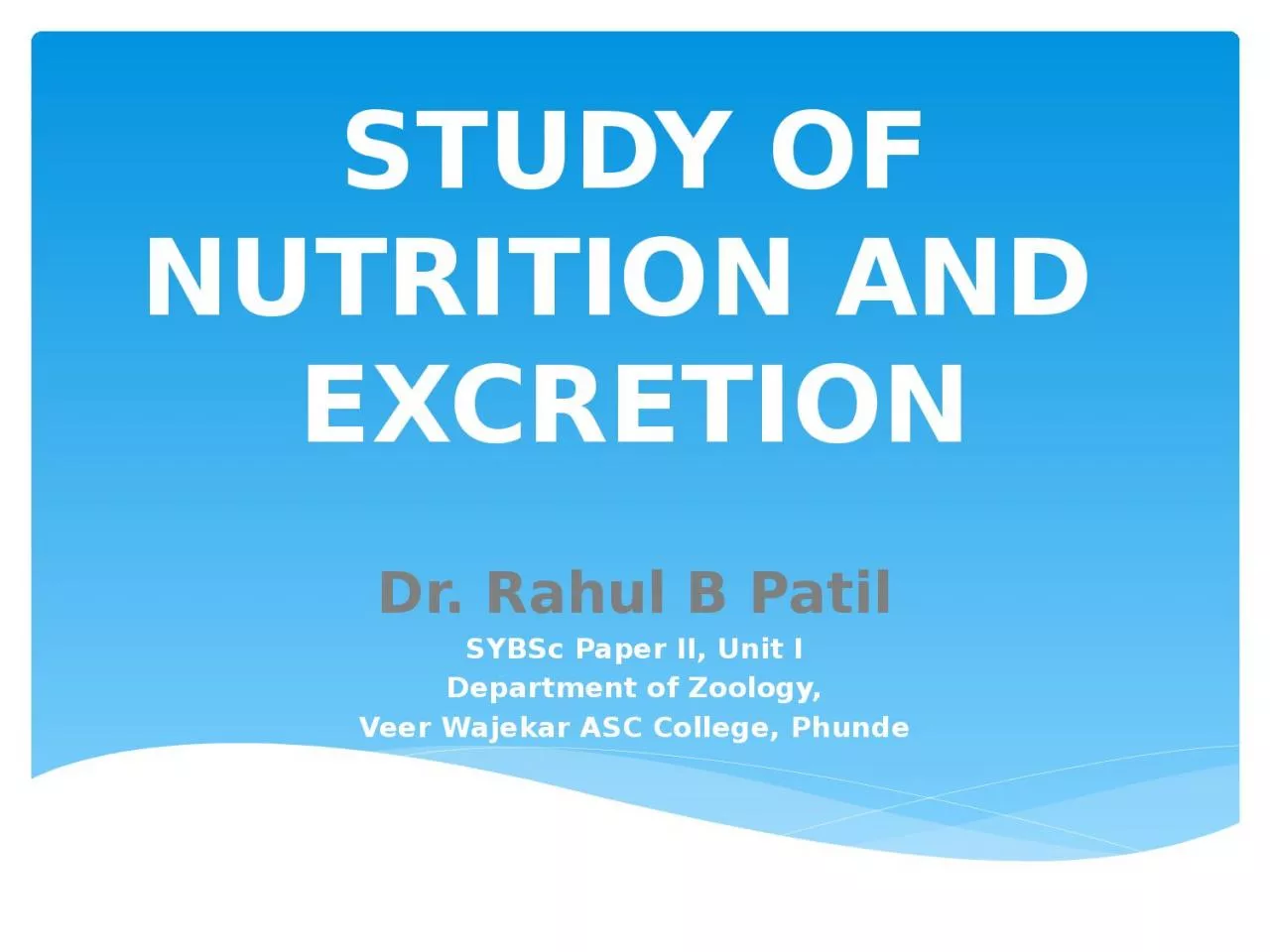

Dr Rahul B Patil SYBSc Paper II Unit I Department of Zoology Veer Wajekar ASC College Phunde Autotrophic Photoautotrophic eg Euglena Volvox Bacteria Chemoautotrophic eg Bacteria few sp of ID: 1034836
Download Presentation The PPT/PDF document "STUDY OF NUTRITION AND EXCRETION" is the property of its rightful owner. Permission is granted to download and print the materials on this web site for personal, non-commercial use only, and to display it on your personal computer provided you do not modify the materials and that you retain all copyright notices contained in the materials. By downloading content from our website, you accept the terms of this agreement.
1. STUDY OF NUTRITION AND EXCRETIONDr. Rahul B PatilSYBSc Paper II, Unit IDepartment of Zoology,Veer Wajekar ASC College, Phunde
2. AutotrophicPhotoautotrophic: e.g. Euglena, Volvox, BacteriaChemoautotrophic: e.g. Bacteria, few sp. of Chilomonos (Oxidation of Compounds)HeterotrophicHolozoic nutrition: e.g. All herbivores, carnivores and Omnivores Saprophytic nutrition: e.g. Bacteria, Protozoans and Fungi etc.Parasitic nutrition: e.g. Entaoemeba, plasmodium, Mosquito, bed bug, Ascaris, etc.Comparative study of Nutritional apparatus
3. IngestionDigestionAbsorptionAssimilationEgestionNutrition
4. Amoeba : Food VacuoleHolozoic mode of NutritionFood: Bacteria, diatoms, desmids, flagellates, ciliates, rotifers etc.Method of Feeding: PhagocytosisDigestion: LysosomesChoosing Food and avoiding others: No Sense organs
5. Hydra: Gastrovascular cavityDigestive system: IncompleteGastrovascular CavityOne opening for food as well as undigested foodTentacles : Food capturingGastroderm: Flagellated, amoeboid and gland cellsGland Cells: Secrete enzymesType of Digestion: Extracellular (Enzymatic digestion) and Intracellular (Phagocytosis)Reserve Food: Fat, Glycogen
6. Earthworm: Complete Digestive System
7. Cockroach: Digestive system
8. Bivalve-Filter Feeder(Digestive System)
9. Amphioxus :Filter Feeder(Digestive System)
10. Pigeon : Digestive system
11. Ruminant stomach
12. Physiology of Digestion in Man
13. Starch Salivary amylase MaltoseUndigested starch Pancreatic amylase MaltoseMaltose Maltase Glucose + Glucose (Malt Sugar)Sucrose Sucrase Glucose + Fructose (Cane sugar)Lactose Lactase Glucose + Galactose (Milk sugar)Digestion of Carbohydrates
14. Proteins, Proteoses Trypsin Polypeptide and Peptones Alkaline mediumPolypeptides Carboxypeptidase Dipeptide Alkaline mediumPolypeptides Polypeptidases Amino Acids + Dipeptides Alkaline mediumDipeptides Dipeptidases Amino acids Alkaline mediumDigestion of Proteins
15. Fat Bile Salts Emulsified Fat Fat globules (Fat Droplets)Emulsified fat Lipase Fatty acids + GlycerolDigestion of Fats
16. ExcretionOsmoregulationComparison between Invertebrate and VertebratesComparative study of Excretory and Osmoregulatory Structures and Functions
17. Amoeba: Contractile Vacuole
18. Planaria: Flame cells
19. Earthworm: Nephridia
20. Cockroach: Malpighian tubules
21. Green gland or antennary gland of Crustaceans
22. Organ of Bojanas: Bivalve
23. Categorization of animals based on Principal Nitrogenous Excretory ProductsAmmonia: Oxidative deamination
24. Categorization of animals based on Principal Nitrogenous Excretory ProductsAmmonia: Non-oxidative demination
25. Categorization of animals based on Principal Nitrogenous Excretory ProductsUrea
26. Uric AcidCategorization of animals based on Principal Nitrogenous Excretory Products
27. Structure of Kidney
28. Malpighian body
29. Structure of Nephron
30. Physiology of Urine formation
31. THANK YOU